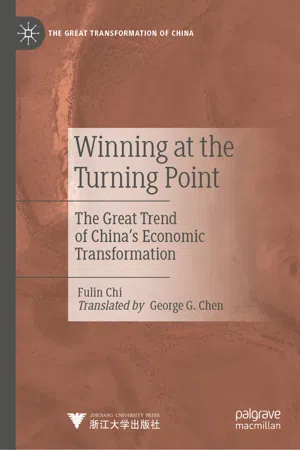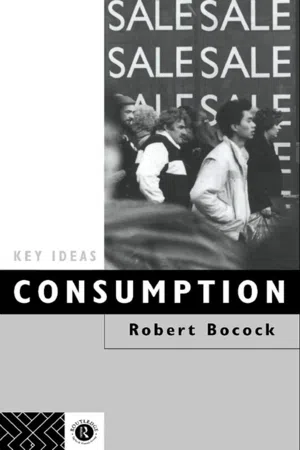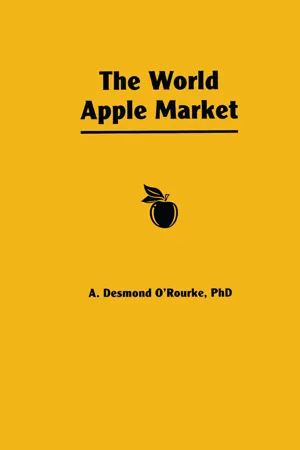Consumption Patterns
Consumption patterns refer to the way individuals or households allocate their spending across different goods and services. These patterns are influenced by factors such as income, preferences, prices, and cultural norms. Understanding consumption patterns is important for analyzing economic trends, forecasting demand for products, and formulating effective policies.
8 Key excerpts on "Consumption Patterns"
- eBook - ePub
Winning at the Turning Point
The Great Trend of China's Economic Transformation
- Fulin Chi, George G. Chen(Authors)
- 2019(Publication Date)
- Palgrave Macmillan(Publisher)
...This process will make a profound impact on the initial distribution pattern and redistribution pattern. It will help to narrow the income gap between the urban and rural areas, between the regions, and between the groups of people. It will help to break the pattern of service industry monopoly, reducing the inequality in income distribution caused by monopoly. And it will help to optimize the structure of government expenditure, thus forming a more reasonable distribution pattern of government, enterprises and residents. 2 Service Consumption as a New Engine of Industrial Change The enormous potential of service consumption in the 13th FYP period is not only a prominent advantage in economic growth, but also a new driving force for economic transformation and upgrading. 2.1 A New Pattern of Consumption-Oriented Economic Growth Will Basically Be Formed In 2015, the contribution rate of final consumption expenditure to the GDP growth was 66.4%, and the forming of a new pattern of consumption-oriented economic growth is becoming a major trend. (1) There is an obvious trend towards the upgrading of consumption structure ① There is still considerable room for improvement in the consumption rate. According to statistics, China’s final consumption rate in 2014 was 51.2%, about 30 percentage points lower than the average in developed countries. This shows that in the next few years there is still large room for improvement in terms of China’s final consumption rate. ② The era of personalized and diversified consumption has arrived. With the change of consumption concept, consumption level and consumption pattern, new consumption focuses will keep emerging. ③ Aging population and population urbanization can boost consumption effectively...
- eBook - ePub
- Dr Robert Bocock, Robert Bocock(Authors)
- 2008(Publication Date)
- Routledge(Publisher)
...Reflecting this bleak and violent economic and political period, sociologists concentrated on other issues, such as the appeal of fascism, rather than upon consumption. The story of the social and cultural role of consumption in modern, western capitalism continued with the growth of what was often called at the time, that is in the 1950s and 1960s, ‘the growth of mass consumption’. There were some interesting features of mass consumption which have been seen as distinctive of the period from the early 1950s up to the late 1960s. From the 1970s to the 1980s, some writers have argued that a new, even ‘post-modern’ pattern of consumption developed. The significance of this will be explored in the last part of this chapter. EARLY PATTERNS OF CONSUMPTION The early patterning of consumption within a distinctively capitalist economic structure began to emerge in England during the post Civil War period, that is in the second half of the seventeenth century. Puritanism, especially in its Calvinist form, exercised considerable influence upon the early bourgeoisie of agricultural and manufacturing capitalism. This was a system of production which employed a legally free wage-labour force (as distinct from slaves or serfs) and which pursued the peaceful, systematic, rational generation of profits through the sale of commodities produced for a free market. Early capitalist forms of production affected British agriculture, for example, earlier than in the rest of Europe, where peasant farming continued. Commercial agriculture developed a ‘free market’ in farm land, in agricultural labour and in the sale of the foods, or other goods, produced on the new-style farms. Some of these new-style commercially oriented farmers were puritans; they were typically neither Roman, nor Anglican, Catholics (Weber, 1970)...
- eBook - ePub
- Peter Catterall, James Obelkevich(Authors)
- 2002(Publication Date)
- Routledge(Publisher)
...But the main focus here is on its three primary aspects: the buying of goods or services; their uses; and, not least, their meanings and cultural significance. It follows from this that consumption is not one activity but infinitely many. It varies from product to product and each has its own story: there is not much in common between the consumption of champagne and the consumption of shampoo. The best way to approach the subject is therefore not through grand theories of consumption in general but through detailed empirical research on a particular product or a particular group of consumers. At this point it is often assumed that since we are all consumers ourselves, such research is unnecessary—that we know everything we need to know about consumption from our own experience of watching television commercials and shopping in Sainsbury’s. If only things were so simple. Most of us know little enough about the consumer habits of the people next door, let alone those in another social class. Similarly with advertising: no matter how closely we examine a television commercial, we can never tell how other people have reacted to it, nor even what the intentions of the advertisers were. There has in fact been a good deal of serious and detailed research on post-war consumption: most of it, however, has been carried out not by sociologists or historians but by market researchers. Since 1945 they have become an essential part of the marketing process, and their work, generally superior to comparable studies by academics, yields a wealth of information and insight on consumer tastes and habits. That most of this material is confidential and closed to outsiders is a matter of regret. There nevertheless remains a great deal of evidence on consumption available to anyone willing to seek it out. Official sources include the indispensable Family Expenditure Survey and the National Food Survey...
- Woodruff Smith(Author)
- 2002(Publication Date)
- Routledge(Publisher)
...The conventional economic factors are obviously of great significance and cannot be ignored, but we are interested in why people decided to consume the things they did, and such decisions are vastly more complicated and involve far more motives than are effectively recognized in economic theory. Having said that, it is now necessary to admit that no other body of theory touching on consumer behavior is alone adequate to the task, despite the recent flurry of interest in consumption among scholars in a wide variety of fields. There is a well-pedigreed literature supplied by sociologists, historians, and some economists that emphasizes the importance of class and status distinctions, of desire to emulate social superiors or compete with peers, as generators of motives for consumption. This category includes, for example, Thorstein Veblen's theory of conspicuous consumption by the “leisure class,” Georg Simmel's classic account of fashion as a recurring cycle of innovation by hegemonic classes and imitation by others, and Harold Perkin's explanation of British economic expansion as the result of consumption by social strata emulating the people just above them in a society with a peculiar multiplicity of class levels. 10 (The last provides much of the conceptual basis for McKendrick's “consumer revolution.”) As we shall see in chapter 2, these class-based approaches can help to account for many Consumption Patterns in the seventeenth and eighteenth centuries, but far from all of them. It is difficult to apply Veblen, for example, to a society in which capitalism was not fully formed, and even then the range of motives he and Perkin examine is clearly too narrow. Simmel cannot explain why some fashions become permanent customs...
- eBook - ePub
- Andrew D O'Rourke(Author)
- 2018(Publication Date)
- CRC Press(Publisher)
...Chapter 3 Apple Consumption Patterns The ultimate goal of the commercial apple industry must be to satisfy the varying needs of consumers. Unfortunately, too often that does not occur. In many cases, the apple industry has not used the existing expertise in government, universities or the private sector in identifying apple Consumption Patterns. In addition, because of the long lag between planning of an orchard planting and first commercial harvest, and the traditional reluctance of growers to remove trees once commercial production begins, very often mature orchards have not adapted to changes in Consumption Patterns. In general, the apple industry has regarded each year’s crop as a gift of nature to be disposed of as profitably as possible. However, the worldwide experimentation with newer varieties, the push for early bearing in high density orchards, and the shorter expected life of orchards means that producers can more precisely target production towards selected consumers. Thus, a better understanding of apple Consumption Patterns is absolutely essential to the success of modern orcharding. PRINCIPLES OF CONSUMPTION The principles governing apple consumption are the same as those governing consumption of all other foods. Food is consumed first to meet the body’s minimal physiological needs, that is, for human survival. At a second level, food is consumed above this threshold to meet the energy and nutritional requirements of normal work and play. At a third level, food is consumed for the enjoyment, satisfaction or pleasure it gives. Populations in a subsistence mode will spend their scarce resources on grains such as wheat, rice or corn. It is only as they reach the second level that fruit will be added to the diet...
- eBook - ePub
- Raymond S. Nickerson(Author)
- 2002(Publication Date)
- Psychology Press(Publisher)
...CHAPTER 9 Consumption, Consumerism, and Environmental Economics In this chapter and several that follow, some topics are considered that represent opportunities, I believe, for psychological research motivated by an interest in finding ways to decrease the detrimental impact of human behavior on the environment. This chapter focuses on consumer behavior and closely related topics such as advertising and consumer education. Subsequent chapters deal with the perception and communication of risk, the psychology of prevention, cost-benefit and trade-off analyses, competition, cooperation, negotiation, and policymaking, among other topics that relate to environmental change and the role of behavior in effecting it. CONSUMER BEHAVIOR The term consumer is a misnomer; we consume little of what we purchase or otherwise acquire. More typically we use something for a while, possibly transforming it in one way or another in the process of wearing it out, and eventually dispose of it as waste. But consumer is the word used to refer to people who purchase, or use, goods and services, and consumption is the term used to denote the behavior in which consumers, as consumers, engage, so those are the terms used here. Consumer behavior has been a major interest of psychologists for several decades. A chapter on consumer psychology was included in the Annual Review of Psychology in 1965 (Twedt, 1965), and the subject has been covered in the same publication several times since then. Research in this area has focused on a broad range of topics, including consumer attitude assessment and change; processing of product information; physiological, affective, or cognitive reactions to specific advertisements; complaint behavior; persuasion; finding predictors of purchasing behavior; and assessing the effectiveness of advertisements in evoking purchasing behavior...
- eBook - ePub
- Edith Kuiper(Author)
- 2022(Publication Date)
- Polity(Publisher)
...It is, however, the direction of the development of what is considered economics that interests us here. Gender differences, in these fields, have been constructed as part of humans’ hard wiring or seen as self-evidently impacting behavior, using an ahistorical approach. Feminist scholars have contested and disproven these claims (see, e.g., Fine, 2010; Rippon, 2019). At the same time, it is clear that these approaches, with their strong focus on individual behavior, lose sight of the rest of the economy, its structure, its institutions, its communities, its social relations, and its history. Consumption and environmental concerns The conceptualization of consumption as the antithesis of production has done more than declare the household as predominantly the site of emotional and social support, shelter, and the provision of needs and the satisfaction of wants. It contributed to turning the economic process into an ahistorical and linear one, and changed the perception of the household into a place where goods are mainly “consumed” – i.e., turned into waste. Taking out its productive features unlinked the household to future generations. Moreover, it made the reproduction of workers and the production of the next generation of workers invisible and took the maintenance of goods, the reduction of waste, its role as part of the community, and the conservation of the environment out of the equation. The idea that, because there is no time or opportunity to have goods fixed, buying new goods is more efficient cannot be defended in any way as a more efficient way of using resources, of course. Instead, this kind of reasoning is mainly based on the externalization of the costs of goods and a lack of information available to the customer. In the decades after World War II, as consumption became increasingly central in US society, it was predominantly women who did the shopping...
- eBook - ePub
Economics After the Crisis
An Introduction to Economics from a Pluralist and Global Perspective
- Irene van Staveren(Author)
- 2014(Publication Date)
- Routledge(Publisher)
...3 Consumption 3.1 Consumer demand 3.1.1 Individual consumer demand This chapter discusses consumer choices. Consumers express agency in consumer markets, under the agency constraints of incomplete information, limited capacity for processing information, risk, uncertainty, and institutions. There are three categories of goods that households demand: final consumer goods, for end use, durable consumer goods, for long-term use and to make domestic labour more efficient, and intermediate consumer goods, which are unfinished goods to which unpaid labour is added to produce final consumer goods. Households demand a variety of services, varying from entertainment (theatre, tourism) to financial services (health insurance, pension savings, and investment plans). The biggest consumer demand by households is for housing: this involves renting at a significant percentage of one’s income. Or it involves buying a durable and non-movable good that is frequently worth several times a household’s annual earnings, which often requires a loan (mortgage), generally varying between 25 per cent and 110 per cent of the house value, with a pay-back period of between 5 and 30 years. Consumer demand in almost every economy in the world today requires purchasing power. In capitalist economies, which are in the majority in our world, purchasing power means money, either cash or in bank accounts. Without money, and hence, some source of income or wealth, one cannot exercise demand in a capitalist market. But not only income matters – prices matter too. Hence, what is relevant for a consumer is real income, which is the purchasing power of income, taking prices into account. The cost of a consumer good, however, is not simply the price paid for it and, hence, a subtraction of available purchasing power. The cost of a consumer good is also its opportunity cost : the value of the alternative forgone. When you buy jeans costing $75, you can’t spend this money on shoes anymore...







